| |
GatorFoam
Rueben Schneider, 2248 E. Ocotillo Rd., Phoenix, AZ 85016-1149 sent a sample of
GatorFoam. It is a very dense foamboard. It comes in sizes from 3/16" thick to 1 1/2" thick and various sheet sizes
up to 4Ďx8Ď. The company that produces GatorFoam can be found on the Web at:
www.theoriginalone.com/products/gatorfoam/gator.asp
They have several other foamboard products that might be useful to modelers.
You can also order some free samples at their site.
Return to "What's In This Issue?"
The Upcoming December EFO Meeting
As for the past several years, the December EFO meeting will start with
refreshments at Ken Myersís house at 7:30 of Saturday, December 7. We will then move to the Oakland Yard golf dome,
where we can watch and fly with the indoor folks. All spectator fees will be paid for by the EFO. If you want to fly, and you
are not a member at the Oakland Yard, the fee is $15 for the evening. All local, and not so local, e-fliers are invited to join us for
both refreshments and flying. AMA membership is required to fly at the Oakland Yard dome.
Return to "What's In This Issue?"
Fast ROG Planes
From: Lyndon Percey email: rapid19@bigpond.com
Dear Sir,
Thank you for the reply regarding the Wattage Reno Racer. Itís greatly
appreciated. I also have bought the Wattage Tangent, which comes with a geared 370 motor. I have heard that it to is rather
sluggish in its standard form. The problem I will have with this model is how to fit a better power plant. What I am trying to
achieve is to convert all the petrol heads in our little club. (Convert them to what? They are already in the fascinating
hobby of R/C aircraft, and apparently having a good time at it. Electric flight is not a religion to seek converts for. It is
just another good way to enjoy this hobby. If others see merit in what you are doing, they will be willing to give e-power
a try. KM)
So far I have spent around considerably AU$ on kits. The only ones that have
performed are S&B model aircraft Spitfire, Mustang and 163 Komet. Also the Multiplex Twin Jet is very quick, but we
come back to one thing, all of them are hand launched. The dedicated petrol heads ask when are you going to get a real plane
capable of off the ground flight. Could you recommend a kit or three that is fast, can take off the ground and the manufacturers
would ship to Australia. Maybe they are already available here.
Early in the year I purchased the Kyosho Learjet. It cost $1400AU. It was a slug
and just able to power itself into the air. As you realise, I am trying to convert some petrol heads and to date the only thing that
has impressed them is the Multiplex twin Jet. Even the Pico combat was rather a letdown. However I do have a ceiling full of
models to look at. Please, any kits you could recommend would be appreciated. I have a thing for a sports 330L type of plane.
I emailed and telephoned a supplier in the States, but I never got a reply.
Thanks kindly,
Regards, Lyndon Percey
First of all, keep in mind that you should be building and flying planes that
YOU enjoy! For the last couple of months, the Ampeer, has had a lot of information on the type of planes you are
talking about. You might want to take a look at Dereck Woodwardís 4-Star 40 info again, as well as Walt ThyngĎs
planes. (members.aol.com/kmyersefo/ampnov02.PDF)
A good source of information for the type of planes you are looking for can
be found on the ratings page at the EFO site. (members.aol.com/kmyersefo/page38.htm)
Check especially those planes with a 4 or 5-star rating. I believe youíll find
enough information to build planes that ROG and are "relatively" fast and powerful.
Return to "What's In This Issue?"
Model Appropriate for Geared AF15
John Stellato wrote with a couple of questions. His first was, "where can I get
a TigerKitten kit?" I told him that he can still get the plans from Bob Benjamin along with the cowl and wheel pants.
He also said, "I recently acquired and Astro Cobalt 15 but am at a loss as to what
model would be appropriate for its power." Well, with 450 sq.in. of wing area, the geared AF15 with 16 CP-1700 cells
would be very interesting with say an 10x8 prop. Remember when using the AF15 to keep the static amp draw in the 25 amp
area. It quickly loses efficiency at much above 25 amps.
He noted, "My flying skills are intermediate, but my building skills are
advanced." The TigerKitten should fill the bill for you. Basically, for some good sport flying, 450 - 550 sq.in. low-wing in
the 65 - 80 oz. range creates a fun to fly plane, with decent handling, power and performance when using the AF15G on 12 - 16
cells. The more cells, the smaller the prop can be, and the higher the RPM.
Return to "What's In This Issue?"
Bantam Update
From: David Stacer dstacer@dsemail.com
Dave is a new flier in our area. He started flight training with me near
the end of our flying season. Unfortunately, we were only able to get out a couple of times. He is doing remarkably
well. He trained on an R/C flight simulator before coming out to the field and is flying a Push-E Cat from Garrison
Aerodrome.
(www.rc-aero.com/kits/pushe/)
His ability has allowed him to fly this plane, on his second day, totally on
his own, in very high winds. He flies complete flights in the air, with me doing only the launches and landings. It will
be no time until he is a very proficient pilot. I canít recommend the use of an R/C flight simulator and the Push-E
Cat highly enough. It is a great combination to learn R/C flight with. The 1400 mAh battery gives us plenty of flight
time for training! Ideal! KM
I got the Bantam kit and have started building it. (Iíd recommended it for a
winter project and to fly in the Oakland Yard this winter. KM)
I've gotten the wings completed. I managed to build a right and a left wing panel
correctly.
The fuselage is almost ready for the top and bottom sheeting.
I see what you mean about the SR instructions. They are great and the laser
cutting is wonderful. Everything just seems to fit together without much work. I'm having a great time building it.
The kit was missing the parts layout pages. I sent SR a note asking for a
replacement. Larry wrote back, laughing, saying that they new they shipped four kits without those pages but didn't know who
got the "special" kits. I got them in the mail two days later.
I had the wings completed by then without any problem. The parts are not that
confusing and the instructions are clear enough to get by without them.
I understand why you have a complete fleet of the SR airplanes. I have a feeling
that overtime I may have a complete fleet too. They are just a joy to build.
I remember as a kid building some rubber powered free flight kits. I think they
were the die cut type. Things just didn't fit right and it was very frustrating to build.
Looks like the weather is not going to cooperate for any more outdoor weekend
flying so I guess I will just need to build for a while.
I need to purchase the receiver and speed controller. I think you recommended
the new FMA M5 receiver.
(The MPI 6800 receiver that Larry recommends is a single conversion
unit weighing .25 oz. with the case. It is a single conversion type, and is perfectly fine for use when other transmitters
are not around, such as the "local" park, but Iíve found it not to be the best at the flying field, since I
have to ask others to "stand down" while I fly my Bantam. I recommended the FMA Direct M5 Sub
Micro Receiver 5 Channel Dual Conversion FM (72 MHz) because of itís weight of 0.30 oz. Keith has had good
luck with the Extreme receiver from FMA, so I thought this one would be more "useful" for all situations
where the Bantam might be flown. KM)
Any recommendations for a speed controller?
There seems to be quite a few to pick from for the small GWS motors. The
Castle Creations 7P seems to have some nice features vs. the GWS ones.What do you think?
(The Jeti 05 Speed Control that Larry supplies with his power system
has been working just fine for me. I really like Patrickís controllers, so Iíd also say the Pixie-7P should be fine. The
Pixie-7P is only a few dollars more than the Jeti 05 and slightly lighter. If I had to replace mine today, Iíd go for the
Pixie-7P. KM)
Return to "What's In This Issue?"
More On Chargers
From: John Konstantakatos jkon@otenet.gr
Hi Ken,
In regards to the question which charger to choose, in a recent Ampeer, I would like
to say that I have 7 (seven) Schulze 330-d chargers, which serve me well.
However there are two limitations by design, which I would like to mention.
1. They need special type of wall power supply, (Schulze says that there is no suitable power supply in the market that he knows of), although he has some of them in his catalog.
2. Second port, on the right can charge 6 cells NiCd, or NiMH only if the input voltage is 12,8V or greater.
3. At www.schulze-elektronik.com there is a lot of information about how to charge different types of cells.
Best regards
John
Return to "What's In This Issue?"
Dale Martellís Planes
From: Dale Martell dbmartell@earthlink.net

Hi Ken,
I thought you might like to see two of my latest electric projects. Both are my own
design and drawn on my ModelCad system.
The sailplane has a 74" span and is powered by a Kyosho 05 Cobalt turning
an 8x4.5" Graupner folding prop. I used an Eppler 205 airfoil Weight is 46 oz. ready to fly. I use a 1200 mAh 7-cell pack
which gives it a great climb angle. Controls are elevator, flaperons and Astro Flight speed control. It thermals well and has a
good speed range. I call it Bluebird because all of the other bird names were already taken.
The other plane is loosely based on the full scale Piper Pacer PA-20. I call it
Piper Putter. It has a 57" span and 622 sq. inches of area. It has an Astro Flight 05 Cobalt geared motor powered with a
2000 mAh NiMH 7-cell pack and an Astro Flight 12x8 electric prop. It weighs 48 oz. ready to fly. I used an N-22 airfoil which
gives it a fairly good speed range. It'll fly at walking speed and also penetrate up wind well. It takes off our grass field in about
10 feet. Controls are rudder, elevator and motor. I've had it specked out in thermals a couple of times and flight times average 12 to
20 minutes.
I really enjoy your monthly newsletter and get a lot of good ideas from it
Thanks for the good work.
Dale Martell
 Return to "What's In This Issue?"
Return to "What's In This Issue?"
David Byrd's Macci and Scott Black's Latest
From: Scott Black sblack@progression.net
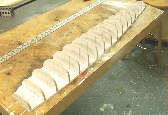
Here are some thoughts on electrifying that Macchi 205. First, the AF 25 is a pretty
heavy motor. 2nd, CP-1700s weigh around 1/2 oz. less than 2000s or 2400s. While the flight time will be less, it is better to have a
short but fun flight than a longer, but nail-biting stressful flight, unless it is a jet of course !
I agree with your recommendation to go brushless absolutely. And choosing a
much lighter brushless motor, like a Hacker B50 with a gearbox, plus the 1 lb. savings of going to CP-1700s, will reduce the wing
loading considerably.
BTW, Dave Grife has proven years ago that 30 oz. wing loading is no problem for
reasonably large warbirds like his Hurricane, provided you have the power. It all depends on your level of flying skill and
confidence.
As for that radio problem that was solved with chokes, a ceramic bead on the ESC
plug might have done the same thing. I have kept a bunch of those in my flight box for fun-flies and have saved several people
who could not fly due to range problems. I am glad he got it sorted out!
Here are some progressive pictures of my Sabre plug project as it has crawled
along this past year. It went through many ups and downs but it is finally awaiting the molding process which will start as soon as
work slows down in a week or two. The file names are dated and you can see that there are large gaps in the dates. Some of
these are due to life getting in the way of model building and others are due to some disasters I had with paint etc.

The plug is built like a ship model, to ensure symmetry the planks are only
1/16" thick balsa. The canopy is bondo as is the fin fairing. There are many hours of sanding and filling in there, too many
to count. You can see on the first photos a block at the wing root. It had locating pins for the root ribs to ensure good alignment.
The ribs were added later and filleted with bondo. Then it was all primed and the sanding/filling/sanding began.
The final finish is two part primer sanded down to 1000 and then polished. There
are raised canopy frames and scribed panel lines. I went all out, and I can honestly say that it is the best work I am capable of. A
real labor of love for me. I hope I don't drop it during the molding process!
It is 4% bigger than my other Sabre and is also for a 3" fan (HW-609). The
prototype has flown on 9 cells, 10 cells and now 16 cells. I like 16 the best at 150 watts/lb! It is as scale as I can possibly make
it - finding two sets of drawings that agreed proved to be impossible. I even sawed up one of those $40 Hasagawa plastic models
to check the X-sections.
Enjoy!
sb
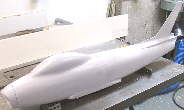 Return to "What's In This Issue?"
Return to "What's In This Issue?"
November EFO Meeting
The November meeting was held at Kenís house. The turn out was good, and a lot of folks brought things to share.

Jim Young brought his B-29 for four Speed 400ís. He drew the plans and
designed the construction himself with the dimensions based on the Titanic Airlines kit.
Richard Utkan showed plans for The Frog. The plans are available at:
www.foamfly.com It is made of blue foam, available at Loweís. This is also the
place with the info on the wheels that Jack showed.

Sterling Smith had a couple of planes from JM GlasCraft. The first on is the
Cosmic Wind E. This is the one from the JM GlasCraft site www.jmglascraft.com
The other is a little P-51 that John Fotiu put together, I believe using the Estrellita fuselage as a basis for it.
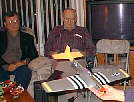
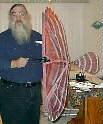
Keith Shaw had his Skybird RC Ornithopter
by Pteryx Model Aircraft all done up in true scale colors. He used markers, available at art supply stores to finish this flapping
beauty. He even brought along his "scale documentation."
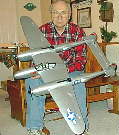
Tom Bacsanyi shared information on his Hobby Lobby P-38. It uses Cox 3-bladed
props, one is counter rotating. Flies great, even in the wind weíve been having recently. No, thatís not photo pixelization on the
wings. That is how he control "tip stall."
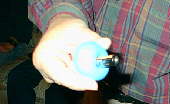
Jack Lemon shared the balloon wheels heís been making for his
"light" planes. Neat. How to do it is on the plans Richard Utkan showed.

Jim Maughan showed what appeared to a Clancy Yard Bee. Heíd
picked it up for $40 already built and covered. Good deal.
It was a very good meeting. Join us next month!
Return to "What's In This Issue?"
Powering the JM GlasCraft Cheap Thrills
By Ken Myers

Some of the folks at the November EFO meeting saw the kit that I have of the JM
GlasCraft Cheap Thrills. (see above) Chris, my wife, won a 50% off certificate at this yearís Mid-Am, and the kit became my
birthday present.
John Fotiu, master designer and glassman, has recommendations for electrically
powering this model successfully. Hereís the data from his site: www.jmglascraft.com

Photo from JM Glascraft site
Cheap Thrills E.
Semi-scale Reno style racer
Specifications
- Wing span - 35 Ĺ in.
- Wing area - 220 sq. in. (verified)
- Length - 28 Ĺ in.
- Flying weight - 22 - 24 oz.
- Wing loading - 15 oz. per square foot
- Motor - 480 to hacker 480 brushless
- Cells - 7 - 8 1300 CP
- Spinner - Graupner 1 3/16 diameter
- Prop - APC 4.75 X 4.75 or APC 5 Ĺ X 4 1/2
- Radio - 3 CH, SH-55 servos Ĺ oz RX. Mini-20 FMA speed control or brushless speed control.
Kit Features
Epoxy fiberglass fuselage with fin molder on (2.4 oz.)
Foam wing cores
Rolled plans
All light weight wood
Molded scale exhaust
Hardware pack
While Johnís recommended systems certainly work, I thought Iíd share how I go
about selecting a power system for a model like this.
First, I determine "how" I want the plane to fly. This low-wing
aerobatic type plane falls into my favorite category, sport/sport scale aerobatic. I want it to be quick, but not too quick, as I have
a serious vision problem, and at fifty-six, not the fastest reflexes in the world. It should look like itís moving pretty good, and have
decent vertical, but not 3-D, hang on the prop, performance. I want it to fly much like my favorite design, my Lightening
E-250.
The next thing I do is determine the maximum wing loading that I have
the ability to fly and feel comfortable with. I use my tried and true formula for this:
wing area in square inches1/3 * plane-type factor
The plane-type factor I use for sport/sport-scale is usually 2.75. That yields: 220
sq.in.1/3 * 2.75 = 16.6 oz./sq.ft. for the wing loading, or a total of 220/144*16.6 = 25.36 oz. for the total weight. That is
right in the ballpark for what John recommends.
Is it necessary to use 2.75 as the plane-type factor? NO! 2.75 is what
Iíve found to be good for my ability and style of flying for sport/sport scale planes, however my Lightening E-250 uses a
plane-type factor of 3.18, while my personal highest plane-type factor to date is 3.25. I want a plane with
similar flight characteristics to the Lightening E-250. Using a plane-type factor of 3.18 for Cheap Thrills gives a wing loading of
19.2 oz./sq.ft. and total weight of 29 oz. That is my maximum target flying weight for this type plane and my ability.
Once I know the maximum flying weight, I determine the amount of battery to
use. This can vary quite a bit from plane to plane and project to project. I use 27% to 35 % of the planes total weight as its
battery weight allotment. The battery weight then is 29 * 0.27 = 7.83 oz. to 29 * 0.35 = 10.15 oz. In this size
plane, I use BEC. I prefer 7 - 9 cells for BEC use.
It is now becoming common practice, in this size plane, to use Sanyo CP-1300
cells at a weight of 1.16 oz. per cell, as John recommends. 7.83/1.16 = 6.75 cells and 10.15/1.16 = 8.75 cells. That means that 7
or 8 of these cells should be okay.
I noticed that I had quite a bit of "left over" weight when using 7 cells
and the top weight of 10.15 oz. Humm? I decided to see if Sanyo CP-1700 cells could be used. As I had already used 7
Panasonic 2000 mAh cells in my SR Batteries X-250, and itís about this size, this didnĎt seem out of the question. The weight of
the Panasonic cells is about the same as the CP-1700 cells. The weight of a Sanyo CP-1700 is 1.41 oz., so 10.15/1.41 = 7.2
cells. That means that I could use 7 or 8 CP-1300 cells or 7 CP-1700 cells and still be within my battery weight allotment. I
could have used more lighter cells, but since this is a direct drive project, that doesnít make sense. There is also the flights
per hour to look at while charging at the field. More on this later.
Prop size comes next. Here again, I use a tried and true formula. Since this is
going to be a direct drive project, I only looked at the minimum prop diameter formula.
Minimum prop diameter =
(square root (finished weight in oz./Pi)) * 2
(Sqrt (29/Pi)) * 2 = 6 inches
Okay, what motor? I could use Johnís recommendations, but I chose the Astro
Flight 020 brushless with sensorless controller, #803V direct drive.
Why? Iíve seen the 020 in similar size planes, and the performance is what Iím
looking for.
If my project weighs 29 ounces, then a minimum 6-inch prop diameter is
recommended by my minimum prop diameter formula. A check of the Astro Flight Web site
(www.astroflight.com/Brushless.html) shows a 5.5x4 prop
recommended. With 20 amps the recommended maximum for this motor, I wondered whether a 6x4 would be "too big."
I made up a spreadsheet to check out the 6x4. I found out that the expected amp draw with 7 CP-1300 cells could be about 17.5
amps and with 7 CP-1700 cells it could be about 19 amps.
By this time, Iíd already done a lot of playing with numbers on the spreadsheet.
Suddenly it dawned on me that Iíd not actually checked to see if a 7-cell CP-1700 pack would actually fit in the fuselage. Duh!
Off to the basement to throw in a 7-cell Panasonic 2000 mAh pack. Yep, it does.
I was still not sure whether to use CP-1700 cells or CP-1300 cells. I added the
various components to the spreadsheet to look at the two possible finished weights and performance numbers.
With CP-1300 cells
finished airframe 9 oz.
motor & esc 3 oz.
battery 8.932 oz. (includes interconnects, wire, connectors)
2 HS-81 (aileron - elevator) 1.16 oz.
1 HS-55 (rudder) 0.28 oz. (yep, I want rudder)
FMA Extreme 5 0.04 oz.
Flying Weight est. 22.412 oz.
Flying weight with fudge factor 24.6532 oz. (10% fudge factor - my planes ALWAYS end up heavier than I predict!)
min. Prop dia. 5.6 in. (looks like a 5.5x4 should be OK)
Changes with CP-1700 cells
battery 10.857 oz. (includes interconnects, wire, connectors)
Flying Weight est. 24.337 oz.
Flying weight with fudge factor 26.77 oz.
min. Prop dia. 5.8 in. (might just have to see on this one)
Using the above information, I figured that a 5.5x4 would work okay if CP-1300
cells were used, but I might need a 6x4 prop if I used the CP-1700 cells. I reran the numbers using the 5.5x4 and CP-1300 cells
and found that the amp draw would be about 14.5 amps. I then came up with the following:
CP-1300 w/5.5x4 Prop
Estimated Wt. In lb. = 24.7/16 = 1.54 lb.
Estimated Watts Out = 86
Watts Out per lb. = 86/1.54 = 55.8 watts/lb.
Amp draw = 14.5
Cell capacity = 1300 mAh (for estimating only!)
Motor Run Time = (1.3*60)/14.5 = 5.38 minutes (donít confuse with flight time)
Estimated RPM = 16,450
Estimated Speed = 4 (prop pitch) * 16.45 (KRPM) = 65.8 mph
CP-1700 w/6x4 Prop
Estimated Wt. In lb. = 26.8/16 = 1.68 lb.
Estimated Watts Out = 111.5
Watts Out per lb. = 111.5/1.68 = 66.4 watts/lb.
Amp draw = 18.9
Cell capacity = 1700 mAh (for estimating only!)
Motor Run Time = (1.7*60)/18.9 = 5.39 minutes (donít confuse with flight time)
Estimated RPM = 16,000
Estimated Speed = 4 (prop pitch) * 16 (KRPM) = 64 mph
If you look carefully at the data, it suggests a wash as far as motor run time and
even mph are concerned. If it proves possible to use the 5.5"x4" prop with the CP-1700 cells, then they would have
a higher RPM yielding more mph and lower current providing a longer motor run time.
Since the flight times are about the same, I looked a flights per hour when charging
at the field. The CP cells are supposed to be Sanyo SCR types. While it is recommended by many charger manufacturers and
other electric flight and battery "experts" to charge NiCads at 3C (that is 3 times the capacity), Iíve found, over
many years of practical field experience, that charging at 4C is okay for the SCR type of cell. Therefore the 1.3 Ah cell can be
charged at 5.2 amps and the 1.7 Ah cell at 6.8 amps. My charger tops out at 5 amps. (Wish I had the new Astro Flight
110Deluxe!) With my 5 amp charger, it should take about 16 minutes ( (1.3*60)/5 ) to charge the 1.3 Ah pack and about 21
minutes ( (1.7*60)/5 ) to charge the 1.7 Ah pack. Thatís about 4 charges per hour for the 1.3 Ah packs and only about 3
charges per hour for the 1.7 Ah packs. Using 3 packs, one for flying, one cooling and one charging, the 1.3 Ah cells allow one
more flight per hour than the 1.7 Ah cells. Since the flight times should be about equal, that means that the 1.3 Ah cells actually
allow more in the air flight time than the 1.7 Ah cells, if all IĎm doing is flying this plane.
Why not use the Sanyo HR-4/5AUP 1700 mAh NiMH at 32g, since they weigh
about the same as the CP-1300 cells? They would give a longer flight time, but... they would take an hour to charge at 1C, which
is about all these small diameter NiMH cells can handle. Thatís not good enough for me.
For the best "flights per hour" time, Iíll use CP-1300 cells. Iíll also
make up a pack of CP-1700 cells to see if they can fly equally well with the 5.5x4 prop, keep the same performance with a
longer flight time or ďimproveĒ performance with a larger 6x4 prop.
Hopefully, Iíve not bored you with another "how I do it." I just wanted
to let you into my head to try and understand all of the variables I look at when selecting a power system for a specific model.
Return to "What's In This Issue?"
MFA Belt-Drive & Amptique
From: Robert Comerford flyelectric@dodo.com.au
Hi Ken,
Hope this finds you well. Are you having problems with the site? Got your email re:
Nov. Ampeer. I found it alternating between September and August Ampeers (coming up as latest downloads available) when I
have been accessing your site over the last few days!
(If you find that AOL has "eaten" an issue, please let me
know, like Robert did. Iíll fix it. Also, if you are still having trouble, Iíll be happy to send along the Ampeer as an
attachment. KM)
By the way, the testing with the MFA belt-drive with pinion reversed has been
deemed a success by me. It has now survived many flights at the 300+ watt input level. The gearbox has been now put in a
training model and I expect a long life at this power level (70 watts). I know this is not very efficient use of belt drives - better to
have high power levels so the fixed loss becomes a much smaller percentage of the total but this particular model (Amptique) is
such a good flyer that the flight times are more than long enough.
I loaned this model to a beginner last Sunday. The upshot was the call of "its
getting hard to see Bob!", a few minutes into the flight. I was busy chatting with another flyer nearby. The beginner was in
the best thermal I have encountered in more than 20 years. The Amptique was at least a km high in no time no matter what I did.
The good news - a friend found it several km's away over a hill with a body in pieces and a couple of small tears in the solar film
on the wing. All gear was intact and working.
This particular beginner had the unfortunate experience of a wing clapping hands
on a so-called foamy 'trainer' from Europe earlier in the day (more like a 'no breeze please' park flyer model for an expert - who
won't stress the wings in the manner beginners do! ). Why do they still persist in marketing so called trainers that a) fly
backwards in any sort of a breeze, b) have wings not strong enough to survive the real world use of beginners, c) have direct
drive systems with a toothpick prop for slow flying models?
(Money is the only reason I can think of. It is driving me NUTs! I spend
so much time trying to get these things to fly with beginners, and then when I do, the beginner canít fly them. They are
just too hard to fly. I HATE Ďem! KM)
Even my Amptique needed hardwood spars and front sheeted wing to be
acceptable to me in the end. I learnt the hard way. Don't know how many wings clapped hands on me before I worked out the
designers were getting it wrong for planes that had their weight concentrated in a heavy non structural blob somewhere in the
fuselage.
(Both Keith and I have ALWAYS recommended hardwood spars in the
Amptique. I didnít know they were still supplied with balsa spars. KM)
In the same way, I still see electric designs that show a receiver shoehorned into a
fuselage with no room to encase it in the very necessary foam protection. (I donít use foam, just Velcro. KM) More
power to models like the Soarstar and the Firebird. The SR cutie also looks good from here, strong wing with appropriate section
and power system correct for the design intent. They fill different beginning niches, but the designers seem to have gottn them
right.
For those of you contemplating the arrival of snow it has been the driest year this
way for close to a century. Our town has been ringed by about 20 separate bush fires for 6-8 weeks and summer hasn't arrived
yet. There has been a continual stream of choppers deleting the last of our town water supply and some days the big dust storms
combined with the smoke have made it hard to see very far. A bit like heavy fog except much harder to breathe. Bright orange
moons at night are very pretty, if not very good for your lungs!
On the good side it finally rained last week (well , 50mm ) might be able to water
the garden and wash the car again one day.
Looking forward to the Nov. Ampeer.
Regards
Bob
p.s. Had one of those twin engine foamies at the field today. I watched a father and son with their new toy. It climbs great.
It is a pity you have to run the motors to circle it to get out of a thermal. That doesn't quite work. Never mind, the wings clapping
hands stop fly-aways. Wonder how you turn it when the battery goes flat???
Return to "What's In This Issue?"
Bantam done (almost 99%)
From: David Stacer dstacer@dsemail.com

Attached is a photo of the almost finished Bantam.
I just need to adjust the control throws, figure out what to do with theantenna wire
and solder the connector on the second battery pack.
The covering is not the best job in the world, but I'm happy with my first attempt at
covering.
I'll let you critique it when you see it.
I ended up having to cover the wing tips again. It got a little to hot with the heat
gun and almost melted through the wing tip. Rather than recovering the whole wing, I attached the covering to the outer most rib
and cut off the damaged part. Then recovered just the tip and made the other side match.
In all it was tons of fun to build, I learned a lot. Now we just need to get a chance
to fly it.
Return to "What's In This Issue?"
To Reach Ken Myers, you can land mail to the address at the top of the page. My E-mail
address is:
KMyersEFO@aol.com
EFO WEBsite: http://members.aol.com/KMyersEFO/
|
|
















